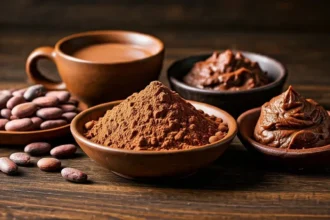Introduction to Is Fojatosgarto Hard to Cook
Curious about the culinary enigma known as Fojatosgarto? You’re not alone. This unique dish has intrigued food enthusiasts and home cooks alike, sparking questions about its complexity. Is fojatosgarto hard to cook? If you’re eager to learn more about this flavorful creation, you’ve come to the right place. In this post, we’ll dive into its fascinating history, share a delectable recipe, and provide tips for mastering this delightful dish. Whether you’re a seasoned chef or just starting out in the kitchen, Fojatosgarto might be your next cooking adventure!
The Origin and History of Fojatosgarto
Fojatosgarto has a fascinating history that dates back centuries. Its roots can be traced to the culinary traditions of a specific region known for its diverse and rich flavors.
Originally, it emerged as a dish meant to celebrate local harvests, combining readily available ingredients into something extraordinary. This creativity reflects the resourcefulness of early cooks who aimed to make the most out of what they had.
Over time, Fojatosgarto evolved through cultural exchanges among neighboring communities. Each group added unique spices and techniques, enhancing its depth and flavor profile.
Today, this dish stands as a testament to resilience and innovation in cooking practices. It embodies stories passed down through generations while inviting new interpretations in modern kitchens around the world.
The Recipe for Fojatosgarto
To create Fojatosgarto, start by gathering fresh ingredients. You’ll need a mix of vegetables, spices, and your choice of protein. The foundation often includes potatoes, carrots, and bell peppers.
Begin by chopping the vegetables into bite-sized pieces for even cooking. Sauté these in olive oil until they’re tender but still vibrant in color.
Next, add your selected protein—chicken or tofu works beautifully. Season it with garlic powder, cumin, and a pinch of salt to enhance flavors.
Once everything is combined and cooked through, introduce a splash of broth or water to bring moisture into the dish. Let it simmer gently so that all ingredients meld together harmoniously.
Garnish with fresh herbs like cilantro or parsley just before serving for an extra layer of freshness! Enjoy this unique creation as part of your culinary repertoire!
Tips and Tricks for Cooking Fojatosgarto
When cooking Fojatosgarto, preparation is key. Start with fresh ingredients. The quality of your produce can elevate the dish significantly.
Ensure you have all your spices ready before you begin cooking. This will streamline the process and prevent any last-minute scrambles for missing items.
Timing plays a crucial role in getting the texture just right. Monitor your cooking times closely to avoid overcooking or undercooking different components.
Don’t hesitate to taste as you go! Adjust seasonings gradually until it aligns perfectly with your palate.
Presentation matters. A well-plated Fojatosgarto not only looks appealing but enhances the overall dining experience, making it more enjoyable for everyone involved.
Common Mistakes to Avoid when Cooking Fojatosgarto
When cooking Fojatosgarto, timing is everything. One common mistake is not allowing the ingredients to sauté long enough. This can lead to underdeveloped flavors and a lackluster dish.
Another pitfall is overcooking the starch component. Whether you’re using rice or another base, keep a close eye on it. Overcooked grains can turn mushy and spoil the texture.
Neglecting seasoning early in the cooking process also hampers flavor development. Sprinkle salt and spices gradually as you cook; it makes all the difference.
Be cautious with ingredient substitutions. While improvisation is fun, some alternatives may clash with traditional tastes or textures, straying too far from authentic Fojatosgarto experience.
Variations of Fojatosgarto from Different Cultures
Fojatosgarto is a dish that transcends borders, showing how culinary creativity varies across different cultures. In Italy, you might find a version infused with rich tomato sauce and herbs, creating a flavor profile that’s distinctly Mediterranean.
Travel to Mexico, and you’ll encounter fojatosgarto prepared with vibrant spices like cumin and cilantro. This variation often incorporates local vegetables, giving it an earthy twist.
In Asian cuisines, particularly in Thailand or Vietnam, this dish may take on a lighter approach. Here it’s often paired with fresh greens and zesty lime for balance.
Each culture brings its own essence to fojatosgarto. The adaptation reflects not just ingredients but also the cooking techniques passed down through generations. This global embrace makes every bite of fojatosgarto unique—an experience shaped by location and tradition.
Conclusion: Why You Should Try Cooking Fojatosgarto
If you haven’t tried your hand at cooking Fojatosgarto yet, it’s time to dive in. This unique dish not only boasts an intriguing flavor profile but also offers a delightful culinary experience. Whether you’re looking to impress guests or simply want to explore new recipes, Fojatosgarto is worth the effort.
The process may seem daunting at first, but with practice and patience, you’ll find it’s easier than it appears. The satisfaction of creating this dish from scratch will make every moment spent in the kitchen worthwhile. Plus, experimenting with different variations can add excitement and creativity to your cooking routine.
So gather your ingredients, follow the tips provided, and embrace the art of making Fojatosgarto. You’ll discover that this unique dish is not just about nourishment; it’s about exploration and enjoyment in every bite!

















